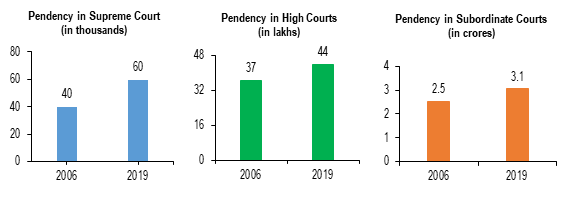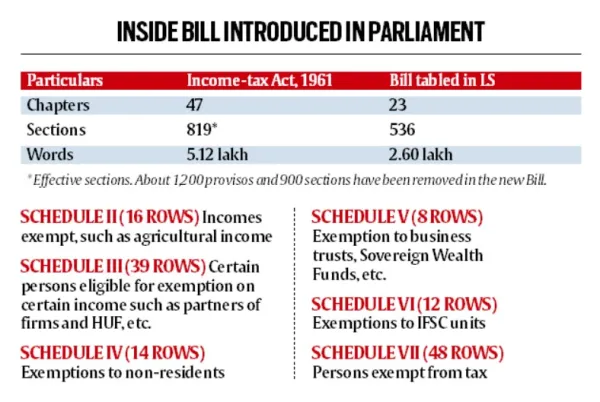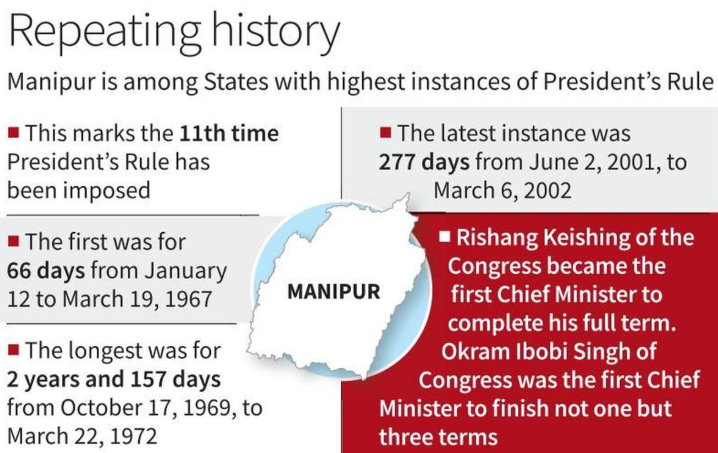Issue of Pendency of Cases in Indian Judiciary
Syllabus: GS2/Polity and Governance
Context
- The Supreme Court permitted High Courts to appoint retired judges on an ad-hoc basis to address the mounting backlog of cases.
About
- The Supreme Court first endorsed the appointment of ad-hoc judges in its 2021 ruling in Lok Prahari v. Union of India.
- These judges were authorised to hear only criminal appeals as part of a bench led by a sitting judge.
- Backlog: As of January 2025, High Courts were burdened with a staggering backlog of 62 lakh cases.

- In 2021, the SC noted there have only been three recorded instances of ad hoc judges being appointed under Article 224A, calling it a “dormant provision”.
Related Constitutional Provisions
- Article 224A of the Indian Constitution allows the Chief Justice of a High Court to request retired HC judges to perform the duties of a judge again, with the permission of the President of India.
- Such appointees are entitled to allowances as determined by the President’s order and have all the jurisdiction, powers and privileges of a Judge of that High Court.
- Lok Prahari v Union of India (2021): SC held that ad hoc judges can only be appointed when recommendations have not been made for less than 20% of the vacancies, after considering both the number of active judges and pending proposals for judge appointments.
Reasons for the Backlog of Cases in Indian Judiciary
- Insufficient Judges: India has one of the lowest judge-to-population ratios globally.
- Increased Litigation: The growing number of litigants and cases, coupled with the increasing population and socio-economic complexities, contributes to the rise in the number of cases.
- Delays in the Justice System: There are delays due to procedural inefficiencies, adjournments, and delays in filing of evidence, which further prolong case resolutions.
- Lack of Infrastructure: Many courts, especially in rural areas, are under-equipped and under-staffed, making it difficult to handle the growing number of cases efficiently.
- Bureaucratic and Administrative Challenges: The judicial process can sometimes be slowed down by inefficiencies in the system, including paperwork, administrative delays, and a lack of modernization in court processes.
How does it impact?
- Delay in Justice: The backlog results in long delays in cases, and justice is often delayed for years.
- Increased No. of Undertrials: The number of undertrials (accused awaiting trial) in prisons has increased, prisons are running at an over-capacity of 114%.
- Increased Costs: The delay in cases causes financial strain on the litigants and the government. It can also result in the erosion of public confidence in the judicial system.
- Overburdened Judges: Judges are often overburdened with cases, leading to burnout and further delays.
Efforts to Address the Issue
- Judicial Reforms: It includes increasing the number of judges, modernizing court infrastructure, and implementing e-courts and technology to speed up hearings.
- Alternate Dispute Resolution (ADR): ADR mechanisms like arbitration, mediation, and conciliation are being promoted to resolve disputes outside of the traditional court system.
- E-Courts and Technology: The E-Courts Project has been an important initiative to digitize court proceedings and allow online hearings. This helps in streamlining case management and reducing physical backlogs.
- Fast Track Courts: Special courts or fast-track courts have been set up to handle specific types of cases like corruption, crimes against women, and long-pending cases to expedite the process.
Source: TH
Concerns Related To China’s Dam Project
Syllabus: GS2/International Relations; Effect of Policies on India’s Interests
Context
- China’s plan to construct the world’s largest hydropower dam on the Brahmaputra River, known as the Yarlung Tsangpo in Tibet, has raised significant concerns among downstream countries, particularly India and Bangladesh.
Implications of China’s Mega-Dam Project
Environmental and Ecological Concerns:
- Altered Water Flow and Sediment Reduction: River Brahmaputra carries vast amounts of sediment that fertilize downstream agricultural lands.
- Chinese dams trap these sediments, reducing soil fertility and affecting farming communities in India and Bangladesh.
- Increased Risk of Flash Floods: Sudden releases of water from Chinese reservoirs could lead to devastating floods in Assam and Arunachal Pradesh.
- There have been instances in the past where unannounced water discharges led to loss of lives and property.
- Biodiversity Loss and Habitat Destruction: River ecosystems, including aquatic species such as the Gangetic dolphin, are under threat due to fluctuating water levels and disrupted breeding cycles.
- Glacial Melt and Climate Change Effects: The Tibetan Plateau, often referred to as the “Third Pole”, is home to the largest volume of ice outside the Arctic and Antarctic. It plays a critical role in the Earth’s cryosphere and influences global climate patterns.
- Seismic Risks: The dam’s location in a seismically active and ecologically fragile Himalayan region raises concerns about potential earthquakes and environmental degradation.
- Such a massive infrastructure project could increase the risk of landslides and other geological disasters.
Geopolitical Ramifications:
- India’s Vulnerability: India, which relies on the Brahmaputra for agriculture and drinking water, fears that China could use its control over the river as a strategic weapon, either by restricting water flow or causing artificial floods.
- Legal and Diplomatic Challenges: International laws governing transboundary rivers, such as the UN Convention on the Law of the Non-navigational Uses of International Watercourses (1997), emphasize equitable and reasonable utilization of shared water resources.
- However, China is not a signatory to this convention, allowing it to exercise unchecked control over these rivers.
- China and India have the Expert Level Mechanism (ELM) since 2006 for hydrological data sharing, but lack a comprehensive treaty.
- Conflict with Southeast Asian Nations: Countries like Vietnam, Cambodia, and Thailand, which depend on the Mekong River, have raised similar concerns over reduced water availability due to China’s upstream damming.
- Economic and Social Impact: Large dam projects often lead to forced relocation of local communities.
- Altered river flows can disrupt irrigation patterns and reduce fish stocks, threatening food security in India and Bangladesh.
India’s Response and Possible Strategies
- Developing Its Own Water Infrastructure: India has been ramping up dam and hydropower projects in Arunachal Pradesh, like the proposed Siang Upper Multipurpose Project (SUMP) to ensure water security and energy generation.
- Strengthening Diplomacy: India has been engaging with Bangladesh and other regional stakeholders to form a united front on transboundary water management.
- Enhancing Satellite Monitoring and Early Warning Systems: Improved satellite surveillance of Chinese dam activities and better flood prediction models can help mitigate risks.
- Exploring Legal Avenues: India could push for regional agreements on water-sharing and seek international arbitration in cases of water disputes.
Draft Advocates (Amendment) Bill, 2025
Syllabus: GS2/Governance
In News
- The Government of India is proposing changes to the Advocates Act, 1961, to strengthen the legal framework.
About the Bill
- The original Act, introduced in 1961, regulates the legal profession, ensures client protection, and maintains the discipline of lawyers through the Bar Council of India and State Bar Councils.
- Law firms are already regulated as corporate entities, but foreign lawyers have previously not been recognized under the Advocates Act.
- The Department of Legal Affairs has prepared the Advocates (Amendment) Bill, 2025, along with a tabular statement comparing existing provisions with proposed amendments.
- It would allow foreign law firms and foreign lawyers to enter India.
Features
- BCI: The BCI would be responsible for regulating law firms, including those operating in multiple states.
- The central government can override the BCI’s regulations if they don’t align with the government’s rules.
- Framework for foreign law firms: The proposed changes could pave the way for foreign law firms to operate in India.
- This is seen as an effort to create a regulatory framework for them.
- Nomination of Members: The central government is proposed to have the power to nominate up to three members to the Bar Council of India, in addition to existing members like the Attorney General and Solicitor General.
- Section 49B proposes that the central government can issue directions to the Bar Council of India for carrying out provisions of the Act and its rules.
- Strikes and Boycotts: It introduces Section 35A which prohibits lawyers from striking or boycotting work if it disrupts court operations.
- Advocates may participate in symbolic or one-day strikes, as long as clients’ rights are not affected.
- Transfer of Bar Council Registration: Advocates will need to pay a fee to transfer their registration from one state bar council to another, with approval from the BCI.
- Removal of Advocates for Serious Convictions: Any advocate convicted of an offense punishable by three or more years of imprisonment will be removed from the state roll, provided the conviction is confirmed by the High Court or Supreme Court.
- Expanded Definitions: The definition of a law graduate is expanded to include those who obtain a law degree (Bachelor’s in law) from recognized legal education centers or universities approved by the Bar Council of India.
- The definition of “legal practitioner” is expanded to include corporate lawyers and those working with foreign law firms.
- Punishment: The punishment for practicing law illegally (i.e., by someone not an advocate) is increased from six months to one year of imprisonment and/or a fine of up to ₹2 lakh.
Importance and Need
- The government continues to reform the legal profession to make it fair, transparent, and accessible to all.
- The amendments are part of the government’s ongoing reform agenda aimed at aligning the legal profession and legal education with global best practices, improving professional standards, and contributing to a just and equitable society.
Freeze on USAID by United States
Syllabus: GS2/ International Relation, Foreign Affairs
Context
- US President Donald Trump has taken steps to close the United States Agency for International Development (USAID).
What is USAID?
- The United States Agency for International Development (USAID) is an independent agency of the U.S. government, established in 1961 by President John F. Kennedy.
- It was created to consolidate various foreign assistance programs under one agency to administer civilian foreign aid and development assistance.
- USAID receives funding allocated in the U.S. federal budget.
- The top recipient countries of USAID include: Ukraine, Ethiopia, Jordan, Somalia etc.
Objectives and Areas of Work
- It operates in over 100 countries, providing financial aid and technical assistance in key sectors such as:
- Economic development, Health and education, Food security and humanitarian assistance, Climate change mitigation and Democracy and governance.
- USAID collaborates with governments, NGOs, businesses, and international organizations, offering grants and assistance for development projects. Some notable initiatives include:
- President’s Emergency Plan for AIDS Relief (PEPFAR), addressing HIV/AIDS treatment and prevention.
- Feed the Future, tackling hunger and food security issues.
- Power Africa, expanding electricity access across Africa.
- Water for the World Act, improving water, sanitation, and hygiene services.
Implications of freeze on USAID
- Impact on U.S. Global Influence: Foreign aid has been instrumental in Washington’s efforts to build alliances and counter geopolitical rivals like China and Russia in developing nations.
- The freeze may reduce U.S. influence in strategic regions.
- Rise of Alternative Development Partners: Countries such as China, through initiatives like the Belt and Road Initiative (BRI), could step in to fill the aid vacuum, increasing their strategic leverage.
- Humanitarian Setbacks: Several vulnerable nations will struggle to meet development goals due to funding cuts, affecting education, healthcare, and infrastructure programs.
USAID’s Role in India
- USAID’s engagement with India began in 1951 under the India Emergency Food Aid Act signed by President Harry Truman.
- The funding freeze is unlikely to have a major impact on India, given its reduced dependence on USAID assistance.
- However, it may affect select ongoing projects in health and sanitation. In 2024, USAID allocated $79.3 million for India’s healthcare sector.
Concluding remarks
- The freeze on USAID funding by the U.S. government has wide-ranging implications for global development efforts.
- While India is relatively insulated from its effects, many developing nations reliant on U.S. aid may face significant challenges.
- The move underscores the need for nations to explore alternative strategies for ensuring sustained development assistance and economic stability.
The Income-tax Bill, 2025
Syllabus: GS3/Economy
Context
- The government has proposed a new bill to repeal and replace the 60-year-old Income-tax Act, 1961, with a simpler and more efficient tax framework.
About
- Income Tax Bill 2025 aims to simplify Income Tax Act 1961. The new bill reduces chapters and words for enhanced clarity.
- It aims to reduce litigation and enhance compliance. Once passed, the proposed legislation will be called the Income Tax Act, 2025, and is expected to take effect in April 2026.

Key Features
- Qualitative Improvements
- Simplified language, making the law more accessible.
- Consolidation of amendments, reducing fragmentation.
- Removal of obsolete and redundant provisions for greater clarity.
- Structural rationalization through tables and formulae for improved readability.
- Preservation of existing taxation principles, ensuring continuity while enhancing usability.
- Crypto as Property: Virtual digital assets such as cryptocurrencies have been included in the definition of property to be counted as a capital asset.
- Dispute Resolution: It provides the points of determination, decision, and the reasons behind it, marking a shift from the earlier section, which lacked clarity on the manner of issuing DRP directions.
- Capital Gain Exemptions: Section 54E of the Act, which details exemptions for capital gains on transfer of capital assets prior to April 1992 has been removed.
- Tax Year: The Bill introduces the concept of “tax year”, which has been defined as the 12-month period beginning April 1.
Conclusion
- Once the Bill is passed in the Parliament, it will be sent to a Parliamentary Standing Committee on Finance for reviewing.
- After a call is taken on including any proposed amendments, the government will decide the date for rolling out the new income tax law.
OTHERS
Sagar Island
Syllabus: GS1/Places in News
Context
- The West Bengal government has announced comprehensive preparations for the Gangasagar Mela 2025.
About
- Sagar Island is situated at the mouth of the Bay of Bengal about 120 km from the State capital Kolkata.
- It is the largest island in the Sundarbans archipelago.
- Lakhs of pilgrims visit the island every year to participate in the religious fair and take a dip at the confluence of the Ganga and the sea on the occasion of Makar Sankranti.
- The site is considered sacred and is home to the Kapil Muni temple.
Source: TH
Manipur Placed Under President’s Rule
Syllabus: GS2/ Polity and Governance
Context
- The Ministry of Home Affairs (MHA) has announced the imposition of President’s Rule in Manipur, with the state assembly placed under suspended animation.
Constitutional Provisions of Imposition of President’s Rule
- Article 356 empowers the President of India to impose President’s Rule in a state when governance cannot be carried out as per constitutional provisions.
- Grounds: If the President receives a report from the state’s Governor or otherwise is convinced or satisfied that the state’s situation is such that the state government cannot carry on the governance according to the provisions of the Constitution.
- Under the President’s rule, the elected state government is dismissed and its powers are suspended.
- The Governor becomes the executive head of the state and runs the administration on behalf of the President.
- The proclamation remains valid for up to two months but must be approved by both Houses of Parliament to extend further.
- If approved, the Rule can last for six months and be extended in increments of six months, up to a maximum of three years.

Source: TH
Heatwaves
Syllabus: GS3/Environment and Conservation
Context
- India is experiencing more frequent, prolonged and severe heatwaves.
- These extreme temperatures pose significant risk to public health, infrastructure, and livelihoods, especially in vulnerable regions.
About
- The World Bank estimates that India could account for 34 million job losses due to heat-stress-related productivity declines by 2030.
- 54% of India’s land is experiencing high-to-extreme-high water stress, according to the World Resources Institute (WRI).
Heatwaves and Its Impacts:
- A heatwave is defined as a prolonged period of unusually and excessively hot weather, accompanied by high humidity.
- The India Meteorological Department (IMD) has specified the following criteria:
- a heatwave need not be considered till the maximum temperature of a station reaches at least 40°C for plains and at least 30°C for hilly regions.
- Impacts:
- Health Risks: Increased heat can cause heatstroke, dehydration, and exacerbate pre-existing conditions like heart disease.
- Agriculture: High temperatures can lead to crop failures, reduce yields, and damage livestock, threatening food security.
- Water scarcity: Heatwaves can worsen droughts, leading to water shortages and affecting drinking water supplies.
- Wildfires: Prolonged heat can increase the likelihood of wildfires, damaging ecosystems and property.
- Energy demand: High temperatures often lead to higher energy consumption for cooling, which can strain power grids.
Source: IE
Removal of Judges In india
Syllabus :GS 2/Governance
In News
- Rajya Sabha Chairman emphasized that only Parliament has the constitutional authority to remove a High Court judge
About Removal of judges
- A judge can be removed on the grounds of ‘proved misbehaviour’ or ‘incapacity’ as per Articles 124 and 217 of the Constitution.
- The Constitution does not define ‘proved misbehaviour’ or ‘incapacity.’
- Supreme Court rulings clarify that wilful misconduct, corruption, lack of integrity, or offenses involving moral turpitude are grounds for misbehaviour.
- Incapacity refers to a medical condition, either physical or mental.
Procedure for Removal
- Procedure for Removal: A judge can be removed only by an order of the President, based on a motion passed by both Houses of Parliament.
- The Judges Inquiry Act, 1968, outlines the removal procedure.
- A motion may be introduced in either House of Parliament.
- In the Lok Sabha, at least 100 members must sign the notice.
- In the Rajya Sabha, at least 50 members must sign the notice.
- The Speaker (Lok Sabha) or Chairman (Rajya Sabha) may consult relevant individuals and decide whether to admit the motion.
- The Judges Inquiry Act, 1968, outlines the removal procedure.
- Motion Admission: The Speaker (Lok Sabha) or Chairman (Rajya Sabha) decides whether to admit the motion after due consideration and consultation.
- Three-Member Committee: If the motion is admitted, a three-member committee is formed:
- A Supreme Court/High Court judge, A distinguished jurist, and A member of the judiciary.
- Investigation and Report: The committee investigates the case.
- If the judge is cleared of misbehaviour or incapacity, the motion is dropped.
- If guilty, the committee report is presented in Parliament for further action.
- Parliament’s Role: If the committee finds misbehaviour or incapacity, the motion is debated in Parliament.
- A motion for removal must be passed by both Houses of Parliament.
- The motion requires:
- A majority of the total membership of each House.
- A special majority of at least two-thirds of members present and voting in the same session.
- Sending the Motion to the President: Once adopted by both Houses, the motion is sent to the President.
- The President will issue an order for the judge’s removal.
